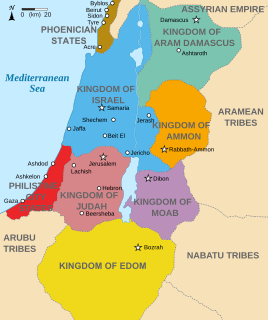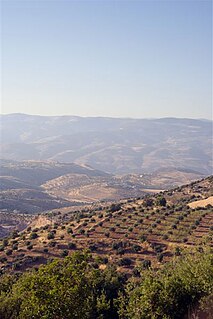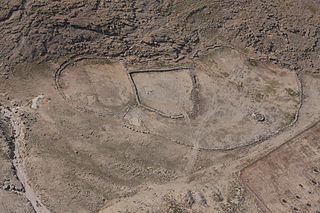Related Research Articles

According to the Hebrew Bible, the Tribe of Ephraim was one of the tribes of Israel. The Tribe of Manasseh together with Ephraim formed the House of Joseph. It is one of the ten lost tribes. The etymology of the name is disputed.
Ramoth-Gilead, was a Levitical city and city of refuge east of the Jordan river in the Hebrew Bible, also called "Ramoth in Gilead" or "Ramoth Galaad" in the Douay-Rheims Bible. It was located in the tribal territorial allotment of the tribe of Gad.
According to the Hebrew Bible, the Tribe of Manasseh was one of the Tribes of Israel. It is one of the ten lost tribes. Together with the Tribe of Ephraim, Manasseh also formed the House of Joseph.

Moab is the name of an ancient kingdom whose territory is today located in the modern state of Jordan. The land is mountainous and lies alongside much of the eastern shore of the Dead Sea. The existence of the Kingdom of Moab is attested to by numerous archaeological findings, most notably the Mesha Stele, which describes the Moabite victory over an unnamed son of King Omri of Israel, an episode also noted in 2 Kings 3. The Moabite capital was Dibon. According to the Hebrew Bible, Moab was often in conflict with its Israelite neighbours to the west.
The Hivites were one group of descendants of Canaan, son of Ham, according to the Table of Nations in Genesis 10 (10:17). A variety of proposals have been made, but beyond the references in the Bible to Hivites in the land of Canaan, no consensus has been reached about their precise historical identity.

According to the Torah, the Tribe of Benjamin was one of the Twelve Tribes of Israel. The tribe was descended from Benjamin, the youngest son of the patriarch Jacob and his wife Rachel. In the Samaritan Pentateuch the name appears as Binyamīm.
In the Biblical Book of Judges, Yair was a man from Gilead of the Tribe of Manasseh, east of the River Jordan, who judged Israel for 22 years, after the death of Tola, who had ruled of 23 years. His inheritance was in Gilead through the line of Machir, the son of Manasseh. Yair was the son of Segub, the son of Hezron through the daughter of Machir.

Gilead or Gilad is the name of three people and two geographic places in the Bible. Gilead may mean 'hill of testimony'. If this is the case, it is likely derived from גלעד gal‛êd, which in turn comes from gal and ‛êd. There also exists an alternative theory that it means 'rocky region'. It is now within the Kingdom of Jordan.

Gilgal is the name of one or more places in the Hebrew Bible. Gilgal is mentioned 39 times, in particular in the Book of Joshua, as the place where the Israelites camped after crossing the Jordan River. The Hebrew term Gilgal most likely means "circle of stones". Its name appears in Koine Greek on the Madaba Map.
Machir or Makir was the name of two figures in the Hebrew Bible:
Jabesh-Gilead is an ancient town referred to in four books of the Hebrew Bible. Some biblical scholars believe it to have been located east of the Jordan River, in the vicinity of Wadi Yabes. The name Jabesh means "dry" in Hebrew.
Tishbe, sometimes transliterated as Thisbe, is a town mentioned in the Hebrew Bible's First Book of Kings, 1 Kings 17:1, as the residence and possibly even birthplace of the Prophet Elijah, known as the Tishbite. It is placed by the biblical text in the historical region of Gilead, now in the western part of modern-day Jordan. However, the toponym may denominate another location, as discussed below.
Machir was the name of a tribal group mentioned in the Song of Deborah in Judges 5, where it is praised for fighting alongside five other Israelite tribes: the Tribe of Ephraim, the Tribe of Benjamin, the Tribe of Zebulun, the Tribe of Issachar, and the Tribe of Naphtali. The Song of Deborah speaks of officers (mechokekim) coming from Machir to join the battle against Sisera.
Gilead was a tribal group mentioned in Biblical passages which textual scholars attribute to early sources. In these sources, for example the Song of Deborah, the Gilead group is treated with equal status to the other Israelite tribes, while certain other tribes, including the Tribe of Manasseh, are absent. An eponymous Gilead is mentioned in the biblical genealogies as a descendant of Manasseh, presumably implying that the Gilead group was part of Manasseh, and since Gilead is also the name of a specific part of the land east of the Jordan River, the Gilead tribal group presumably refers to the half tribe of Manasseh which resided on this side of the Jordan. The identity as part of a single tribe named Manasseh, doesn't appear to have been fully accurate in practice, since there was very little geographic connection between the two half tribes, only just touching at a corner of each, and according to the Book of Chronicles each half tribe historically had always had separate tribal rulers.

Manasseh or Menashe was, according to the Book of Genesis, the first son of Joseph and Asenath. Asenath was an Egyptian woman whom Pharaoh gave to Joseph as wife, and the daughter of Potipherah, a priest of On. Manasseh was born in Egypt before the arrival of the children of Israel from Canaan.

Edom was an ancient kingdom in Transjordan located between Moab to the northeast, the Arabah to the west and the Arabian Desert to the south and east. Most of its former territory is now divided between Israel and Jordan. Edom appears in written sources relating to the late Bronze Age and to the Iron Age in the Levant, such as the Hebrew Bible and Egyptian and Mesopotamian records.
According to the First Book of Chronicles, Segub was the son of Hezron and Machir's daughter and the father of Jair. Jair controlled 23 towns in Gilead at that time.
References
- ↑ Deuteronomy 3:4-5, Joshua 13:30, 1 Chronicles 2:23
- ↑ 1 Kings 4:13
- ↑
 This article incorporates text from a publication now in the public domain : Singer, Isidore; et al., eds. (1901–1906). "Havoth-Jair". The Jewish Encyclopedia . New York: Funk & Wagnalls.
This article incorporates text from a publication now in the public domain : Singer, Isidore; et al., eds. (1901–1906). "Havoth-Jair". The Jewish Encyclopedia . New York: Funk & Wagnalls.